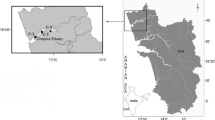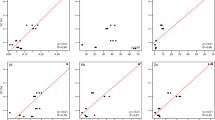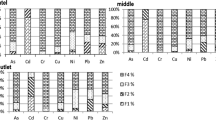Abstract
This investigation evaluated the bioaccumulation potential of the tropical estuarine bivalve Anomalocardia flexuosa for trace metals. To this aim, chemical and sedimentological analyses and bioaccumulation tests were performed. The sediments were mainly composed by fine-sands and mud, with variable levels of organic matter and CaCO3. Muddy sediments from a depositional site (P2) presented the highest concentrations of metals, despite SEM/AVS not indicating bioavailability. Bioaccumulation factors showed high ratios for Cd, Ni, and Zn, while associations between the contents of mud, organic matter, CaCO3 and metals in sediments and tissues of A. flexuosa were indicated by a principal component analysis. The SEM/AVS was not effective to predict the bioavailability through dissolved metals. The results showed that contaminants were bioavailable, while the performed bioaccumulation test proved to be a reliable technique for assessing sediment contamination in estuarine regions. Moreover, A. flexuosa was considered an adequate test organism for bioaccumulation studies.


Similar content being viewed by others
References
Aguiar V, Braga E, Baptista-Neto J (2008) Heavy metal assessment in two subtropical estuarine systems in the state of São Paulo, Brazil. In: Hofer TN (ed) Marine pollution: new research. Nova Science Publishers, pp 379–397
Allen HE, Fu G, Deng B (1993) Analysis of acid-volatile sulfide (AVS) and simultaneously extracted metals (SEM) for the estimation of potential toxicity in aquatic sediments. Environ Toxicol Chem 12:1441–1453
Amorim E, Fávaro D, Berbel G, Braga E (2008) Assessment of metal and trace element concentrations in the Cananéia estuary, Brazil, by neutron activation and atomic absorption techniques. J Radioanal Nucl Chem 278:485–489
Araujo G, Cruz A, Gusso-Choueri P et al (2020) Sediment quality of a Ramsar site assessed by chemical and ecotoxicological approaches. Reg Stud Mar Sci 35:101145
Campos B, Cruz A, Buruaem L et al (2016) Using a tiered approach based on ecotoxicological techniques to assess the ecological risks of contamination in a subtropical estuarine protected area. Sci Total Environ 544:564–573
CETESB (2014) Qualidade das águas superficiais no estado de São Paulo 2013. CETESB, São Paulo, p 434
Chapman PM, Anderson J (2005) A decision-making framework for sediment contamination. Integr Environ Assess Manag Int J 1:163–173
Chapman PM, Hollert H (2006) Should the sediment quality triad become a tetrad, a pentad, or possibly even a hexad? J Soils Sediments 6:4–8
Choueri R, Morais R, Pereira C et al (2009) Development of site-specific sediment quality values (SQVs) using the weight of evidence (WOE) approach for North and South Atlantic littoral zones. J Hazard Mater 170:320–331
Cruz ACF, Davanso MB, Araujo GS et al (2014) Cumulative influences of a small city and former mining activities on the sediment quality of a subtropical estuarine protected area. Environ Monit Assess 186:7035–7046
Cruz ACF, Gusso-Choueri P, de Araujo GS et al (2019) Levels of metals and toxicity in sediments from a Ramsar site influenced by former mining activities. Ecotoxicol Environ Saf 171:162–172. https://doi.org/10.1016/j.ecoenv.2018.12.088
de Mahiques MM, Burone L, Figueira RCL et al (2009) Anthropogenic influences in a lagoonal environment: a multiproxy approach at the valo grande mouth, Cananéia-Iguape system (SE Brazil). Braz J Oceanogr 57:325–337
de Miranda L, de Mesquita A, França CAS (1995) Estudo da circulação e dos processos de mistura no extremo sul do Mar de Cananéia: condições de dezembro de 1991. Boletim do Instituto Oceanográfico 43:153–164
Di Toro DM, Mahony JD, Hansen DJ et al (1990) Toxicity of cadmium in sediments: the role of acid volatile sulfide. Environ Toxicol Chem 9:1487–1502
Di Toro DM, Mahony JD, Hansen DJ et al (1992) Acid volatile sulfide predicts the acute toxicity of cadmium and nickel in sediments. Environ Sci Technol 26:96–101
Fernandez WS (2011) Dinâmica populacional, análise das concentrações de metais e utilização de biomarcadores em Mugil curema Valenciennes, 1836 do estuário de Santos e do sistema costeiro Cananéia-Iguape, São Paulo, Brasil
García AA (1999) Diagnóstico ambiental da Lagoa da Conceição e do canal da Barra através de indicadores fisico-químicos dos sedimentos de fundo e dos indicadores sócio-ambientais: Florianópolis, Santa Catarina, Brasil
Guimarães V, Sígolo JB (2008) Associação de resíduos da metalurgia com sedimentos em suspensão-Rio Ribeira de Iguape. Geologia USP Série Científica 8:1–10
Gusso-Choueri PK, Choueri RB, de Araújo GS et al (2015) Assessing pollution in marine protected areas: the role of a multi-biomarker and multi-organ approach. Environ Sci Pollut Res 22:18047–18065
Hameedi J, Harmon M, Haverland P et al (1997) General guidelines for using the sediment quality triad. Mar Pollut Bull 34:368–372
Hirota J, Szyper JP (1975) Separation of total particulate carbon into inorganic and organic components. Limnol Oceanogr 20:896–900
ICMBio (2016) Plano de Manejo: Área de Proteção Ambiental Cananéia-Iguape-Peruíbe, SP. Instituto Chico Mendes de Conservação da Biodiversidade (ICMBio). Iguape, Brasil. https://www.icmbio.gov.br/portal/images/stories/DCOM_plano_de_manejo_Apa_Cananeia_Iguape_Peruibe_03032016.pdf. Access on 18 June 2020
Kehrig HA, Costa M, Moreira I, Malm O (2006) Total and methyl mercury in different species of molluscs from two estuaries in Rio de Janeiro State. J Braz Chem Soc 17:1409–1418
Kuniyoshi LS (2011) Bioacumulação de elementos traço e expressão de micronúcleos em Cathorops spixii (biomonitor) como ferramentas de avaliação da influência antrópica em dois setores do complexo estuarino-lagunar de Cananéia-Iguape, São Paulo, Brasil
Lee R (1992) Models, muddles, and mud: Predicting bioaccumulation of sediment-associated contaminants. In: Burton GA Jr (ed) Sediment quality assessment. Lewis Press, Boca Raton, pp 267–291
Luczak C, Janquin M-A, Kupka A (1997) Simple standard procedure for the routine determination of organic matter in marine sediment. Hydrobiologia 345:87–94
Machado W, Carvalho M, Santelli R, Maddock J (2004) Reactive sulfides relationship with metals in sediments from an eutrophicated estuary in Southeast Brazil. Mar Pollut Bull 49:89–92
Miyao SY, Harari J (1989) Estudo preliminar da maré e das correntes de maré da região estuarina de Cananéia (25 S-48 W). Boletim do Instituto Oceanográfico 37:107–123
Moraes MBR (2004) Área de Proteção Ambiental APA como agência de desenvolvimento sustentável: APA Cananéia Iguape Peruíbe/SP. Anna Blume
Morais LG, Abessa DM (2014) PSR framework applied to the coastal management of “Complexo Estuarino-Lagunar Iguape-Cananéia”–CELIC (São Paulo, Brazil), in terms of sanitation and public health. Revista de Gestão Costeira Integrada/J Integr Coast Zone Manag 14:625–635
Moreira LB, Sasaki ST, Taniguchi S et al (2020) Biomarkers responses of the clam Anomalocardia flexuosa in sediment toxicity bioassays using dredged materials from a semi-arid coastal system. Heliyon 6:e04030
Mouëza M, Gros O, Frenkiel L (1999) Embryonic, larval and postlarval development of the tropical clam, Anomalocardia brasiliana (Bivalvia, Veneridae). J Molluscan Stud 65:73–88
Mudroch A, MacKnight SD (1994) Handbook of techniques for aquatic sediments sampling. CRC Press
Poleza F, Souza RC, Resgalla C (2014) Identification of the toxic constituents of sediments in a Brazilian subtropical estuary. Mar Pollut Bull 80:71–79
Power E, Chapman P (1992) Assessing sediment quality. In: Burton GA (ed) Sediment toxicity assessment. Lewis Publishers, Boca Raton, pp 1–18f
Silva CAR, Smith BD, Rainbow PS (2006) Comparative biomonitors of coastal trace metal contamination in tropical South America (N. Brazil). Mar Environ Res 61:439–455
Silva-Cavalcanti JS, Costa MF (2011) Fisheries of Anomalocardia brasiliana in tropical estuaries. Pan-Am J Aquat Sci 6:86–99
Smith S, MacDonald D, Keenleyside K, Gaudet C (1996) The development and implementation of Canadian sediment quality guidelines. In: Munawar M, Dave G (eds) Development and progress in sediment quality assessment: rationale, challenges, techniques and strategies. SPB Academic Publishing, Amsterdam, pp 233–249
Torres RJ, Cesar A, Pastor VA et al (2015) A critical comparison of different approaches to sediment-quality assessments in the Santos estuarine system in Brazil. Arch Environ Contam Toxicol 68:132–147
USEPA (1993) Guidance manual: bedded sediment bioaccumulation tests. AScI Corp., Newport, OR (United States)
USEPA (1995) Method 3051: microwave assisted acid digestion of sediments, sludges, soils, and oils. In: Test methods for evaluating solid waste, pp 1–30
USEPA (2000) Technical basis for the derivation of equilibrium partitioning sediment guidelines (ESGs) for the protection of benthic organisms: nonionic organics. AScI Corp., Newport, OR (United States)
Acknowledgements
The authors thank to the crew of Albacora and all staff from the South Basis of the “Instituto Oceanográfico da USP” for the logistic support. We thank the staffs from the NEPEA-UNESP, Universidade Federal Fluminense (UFF) and State University of Campinas (UNICAMP) for the assistance during the experiments and analyses. This investigation was supported by CAPES (Brazilian Agency for Science and Technology) and CNPq (Brazilian National Council for Scientific and Technological Development). DMSA and WM thanks for CNPq for the financial support.
Author information
Authors and Affiliations
Corresponding author
Additional information
Publisher's Note
Springer Nature remains neutral with regard to jurisdictional claims in published maps and institutional affiliations.
Supplementary Information
Below is the link to the electronic supplementary material.
Rights and permissions
About this article
Cite this article
Cruz, A.C.F., Pauly, G.F.E., Araujo, G.S. et al. Metal Bioaccumulation by the Neotropical Clam Anomalocardia flexuosa to Estimate the Quality of Estuarine Sediments. Bull Environ Contam Toxicol 107, 106–113 (2021). https://doi.org/10.1007/s00128-020-03062-x
Received:
Accepted:
Published:
Issue Date:
DOI: https://doi.org/10.1007/s00128-020-03062-x




